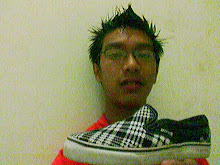
WHAT makes Brunei's traditional textile of batik uniquely diffferent from designs used in other countries?
Incorporating the elements of the national flower of simpur, sumboi-sumboi (pitcher plant) and Brunei's traditional design of air muleh in the textile is one way of localising batik in the eyes of Brunei and the world, according to Hjh Raziam Ibrahim, owner of a batik collection.
Such elements are important to create a distinction between local batik to those in Malaysia and Indonesia and to create a niche market for Brunei's batik, she said.
Hjh Raziam said her passion with batik started in the early 1970s. Her interest, coupled with talent, creativity and hard work saw her increasingly gaining reputation in the industry.
With 36 years of experience in batik painting, Hjh Raziam's main aim was to promote batik products in Brunei.
She said that it was important for youths to be aware of the opportunity as she saw a lot of them showing an interest and have the potential to make it big in the market.
Good quality of batik can be attributed to the different techniques used to create batik designs such as airbrushing, cracking, bubble, rainbow, sprinkle, geometry and marble.
These techniques applied on the fabric (cotton, chiffon, linen and brocade), together with the art of layering and mixture of colours and creativity would create an exclusive hand-made batik design, she said. The designs in the collection are exclusive, no two designs were the same, she added. In addition to batik cloth, she produces other batik-related products such as handbags, bedsheets and cushion covers.
She hoped that the younger generation would be interested to learn this art form.
"The youths nowadays are more creative and have huge potential especially in art and design," she said.
Hjh Raziah said that one of the challenges in the industry is the need to always improve and create new designs.
She added that students who learnt art and design benefitted the most as they have the basic techniques and can apply their creativity in creating attractive batik designs.
When one has the knowledge, one could improve oneself, particularly if accompanied with hard work, she said.
She said that she came across youths who were interested in learning about batik design, but unfortunately they lacked the commitment.
"One may find the art of batik painting boring if they do not have the passion," she said, adding that one must brace oneself to the tasks ahead as batik painting is a lengthy process.
The most common question asked by consumers was the cost of purchasing batik, which could reach up to hundreds of dollars. Some consumers would appreciate the art and the creativity of the artists, and the price reflects the quality of the batik they are purchasing, she said.
The cost of materials used in producing batik itself could easily reach hundreds of dollars, she said, adding that materials include the fabric and colours which have to be bought from neighbouring countries as they were not available in Brunei.
Hjh Raziah said that she does not have her own shop but supplies her products to various textile shops and participates in various expositions.


















No comments:
Post a Comment